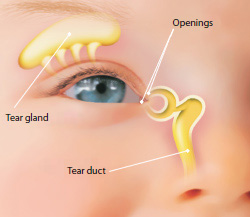Eye problems

![]() Tears are secreted by the tear gland. They spread across the surface of the eye, then flow through small openings from the eye to the nasal cavity via the tear duct.
Tears are secreted by the tear gland. They spread across the surface of the eye, then flow through small openings from the eye to the nasal cavity via the tear duct.
Illustration: Bertrand Lachance
Children under two can sometimes have eye problems. Most commonly, their eyes can be red, sticky, or watery, or they can be cross eyed.
Red, sticky, or watery eyes
A red, sticky, or watery eye can have a variety of causes:
Blocked tear duct – Normally, tears flow from the eye to the nose via the tear duct. If the duct is blocked or not fully open, tears build up, causing the eye to water.
Your baby may wake up with a crusty eye, but with no pain, redness, or swelling of the eyelid. You can gently wash the eye with a clean washcloth soaked in warm water.
If the tear duct is not already open at birth, it usually opens by itself during the first year of life. Massaging can help the tear duct open more quickly. To learn how to perform this massage or if the problem persists after one year of age, talk to the nurse or doctor at your next visit.
Foreign object in the eye – If one of your baby’s eyes becomes red all of a sudden, tears up a lot, or if your baby refuses to open his eye or is uncomfortable, he may have a foreign object in his eye. To find out what to do, read the section on Foreign object or chemical product in an eye.
Allergies – If your baby’s eyes are itchy, irritated, or watery, and the redness is mild to moderate, an allergy may be the cause (see Allergies).
Infection – These are the signs of an eye infection:
- Red eye
- Swollen, sticky eyelids
- Yellowish secretion (pus)
- Trouble opening the eyes and looking at a light
Eye infections can be caused by a bacteria or a virus. They can sometimes occur after a cold, flu, or sore throat caused by a virus.
What to do?
If your baby has one or more of the signs of eye infection just mentioned:
- Wash your hands often to avoid spreading the germs.
- Gently wash the eye with a clean washcloth soaked in warm water.
- See a doctor or optometrist, if necessary.
Vision problems and crossed eyes (strabismus)
Very few young children complain of vision problems because they tend to think their vision is normal. To prevent vision problems from becoming permanent and having long-term consequences, they should be corrected as soon as possible.
Your newborn’s eyes may occasionally be crossed. Don’t worry, this happens to many babies. This phenomenon, called strabismus, often disappears by the time the baby is 2 or 3 months old when he develops the ability to focus and move both eyes in the same direction.
You can be attentive to early signs that may indicate that your baby has a vision problem. See a doctor or optometrist if your baby:
- Is constantly cross eyed from birth.
- Appears to be cross eyed after the age of 3 months.
- Has a white reflection (not red) in the pupil.
- Doesn’t follow moving objects with his eyes.
- Blinks frequently.
- Is very sensitive to light and has very watery eyes.
- Cries when one of his eyes is covered.
- Knocks into things and has trouble orienting himself.
Pupil: The black centre inside the coloured part of the eye.


